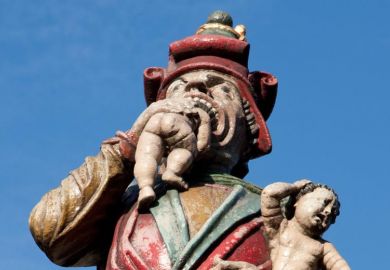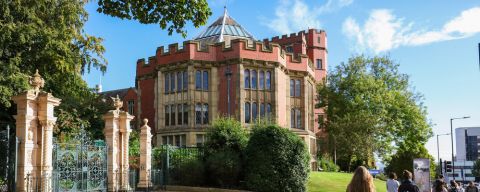A lunch with Allan Goodman at an Italian restaurant near to the United Nations headquarters in New York was an important meeting for me.
Allan is president of the Institute of International Education, the organisation founded at the end of the First World War, which is dedicated to promoting education worldwide and promotes such flagship programmes as the Fulbright Scholarships. It has played a pivotal role in linking the worldwide academic community.
What you may not know is that the institute has also been particularly important in providing safe havens for scholars displaced from their homes by war and persecution.
Allan is not only a wise and thoughtful leader, he has a truly unique perspective on what the US thinks of students and scholars who visit America, and who sometimes want to stay. He is a quiet man of action.
What I did not know when we ordered lunch was that I was about to be part of a tutorial, with me as the student. We talked about the changing view in many places around the world about openness to others and immigration, and how this will most likely lead to a potential closing of a Golden Age of international education.
As we spoke, like all good teachers he challenged my assumptions. I started to realise how damn little I knew of the real story behind immigration in the United States, despite having lived and worked there as a scientist for the best part of a decade.
Allan explained that the changes under way in the US were not, as I had thought, a political aberration, but rather the country returning to more normal ways of working. That Trump’s approach is no deviation from the American way, that “America First” is simply business as usual.
I had of course heard about the huddled masses that came through Ellis Island before the 1920s. In the later years this was responsible for a wave of Jewish immigrants that made New York what it is today. But I knew little about the powerful anti-immigrant feelings that led to the brutal quota system that America introduced in the 1920s. I was shocked as I learned of the reality of the US “welcome” to scholars in the time when persecution of German Jews was beginning in earnest.
So how did it work? The quota for immigrants to enter the US when immigration laws were tightened in 1924 was set at just 2 per cent of the total number of people from that country who had been living in the US at the time of the 1890 national census. This meant that, in theory, about 25,000 Germans were eligible to come to the US each year. But government rhetoric does not always coincide with the reality of the operation of its bureaucracy. Through the tight operation of its entry processes and a deliberate resistance to immigration, the real number in 1933, for example, was only just over a thousand.
In spite of influential voices pleading in Washington, in particular that of associate justice of the Supreme Court Louis Brandeis, as the evidence accrued of persecution there was still no let-up in the prevention of German Jews coming to the US. Economic interests and latent anti-Semitic feeling in parts of government meant that, even up to the war, the calls to help fell on deaf ears.
The consequences were felt in human lives – in 1939, long after the notorious Kristallnacht, the liner SS St Louis carried 900 refugees across the Atlantic. Unable to enter the US owing to strict immigration quotas, the passengers were returned to Europe. The ship then went from port to port as countries took a few of the refugees, but 620 were returned to Germany where it is thought half died in the Holocaust. The Nazis even used this rejection to reinforce the perception that such people were clearly “undesirable”.
So what of America’s famous refugee scholars? What about Einstein and his scientific peers?
Allan explained that the only way even the most distinguished scientists fleeing Nazi Germany could enter the US was through their being adopted by a college or university that was willing to take them on “parole”. For a visiting scholar a substantial bond was required to enable them to stay in the US.
And it took people prepared to take that responsibility. He told us the inspiring story of Ruth Gruber, the photojournalist who became a humanitarian because she could not look away from need – who mounted an utterly determined campaign and was arguably personally responsible for the bulk of the refugees that were able to stay in the US. Ruth was one of the key supporters of Allan’s wonderful organisation.
I was astonished at the modest number of refugees who came to research and teach at US universities who had transformed my subject, and who had had such an extraordinary effect on American academia. But then I thought of the impact that those who sought asylum in Britain had in our own universities and who had taught me as a student. I thought of all my wonderful colleagues across the US who were trained by men like Ugo Fano. So I was shocked but buoyed up at the same time. I was sad and happy.
I was deeply shocked and sad at the thought of all the people, including scientists and scholars, who had died because they could not leave. But I was inspired by the idea that there is a great benefit to be gained by saving even one scholar. It reinvigorated me to go back and tell the story again of the importance of our saving every scholar we can. To tell the story to those who would see a Muslim scholar from Syria as a potential terrorist, rather than a true blessing to our academia, and our society.
I then read the words of Brandeis, who had said he was truly ashamed of the response of the US to the imprisonment and slaughter of German Jews. But Brandeis’ other words came to mind. He was following Goethe’s famous maxim, “One is the master through the details”, when he said: “Go home, select a little thing and do that thing well, the rest will follow.”
And that is what I shall do, refreshed by listening to a good man – by which I mean a man who understands and then acts around the world and in his own country – who knew the real story of how hope comes from individuals who can see the stranger in the midst of their own family. Refreshed by hearing the story of how Gruber single-handedly saved a thousand refugees. Refreshed by knowing that saving the world one person at a time is possible, and that we in universities as much as anyone have a role if we accept it.
In his address to the WUN President’s Forum the next day, Allan told us that if every one of the roughly 15,000 universities of the world took just one student and scholar at risk we would transform our planet for the better. At this time there are just 10,000 looking for placements, so we would even have an embarras de richesses in homes for them to go to.
There is a need for action in our own time. We have a choice. And we make it one student, one scholar at a time.
Sir Keith Burnett is vice-chancellor of the University of Sheffield, and co-founded the #WeAreInternational campaign which is closely allied to the US sister campaign, #YouAreWelcomeHere.
Register to continue
Why register?
- Registration is free and only takes a moment
- Once registered, you can read 3 articles a month
- Sign up for our newsletter
Subscribe
Or subscribe for unlimited access to:
- Unlimited access to news, views, insights & reviews
- Digital editions
- Digital access to THE’s university and college rankings analysis
Already registered or a current subscriber?









